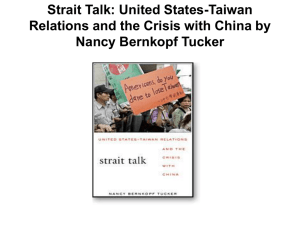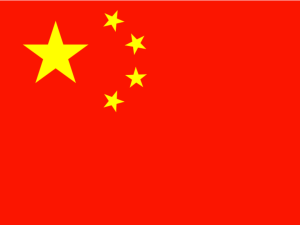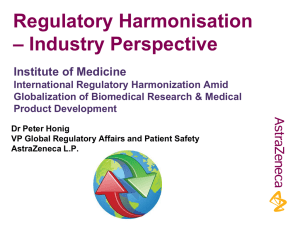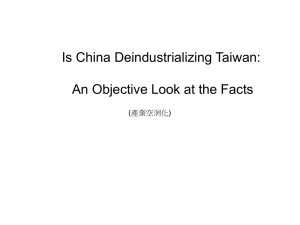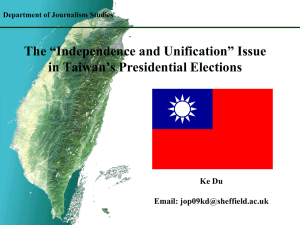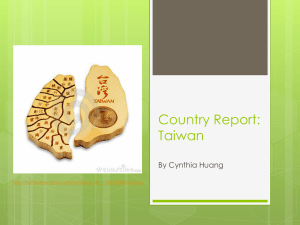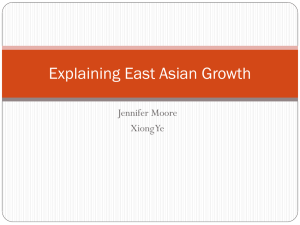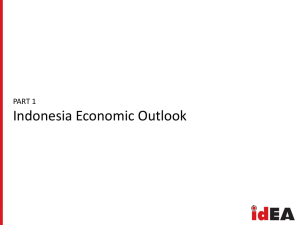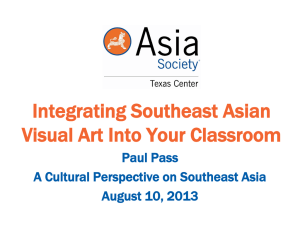How Asians View A Rising China
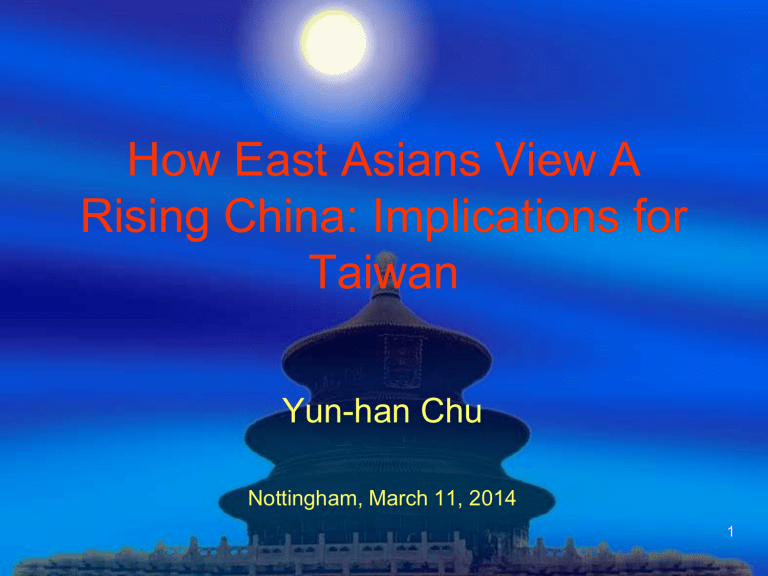
How East Asians View A
Rising China: Implications for
Taiwan
Yun-han Chu
Nottingham, March 11, 2014
1
Competition over Soft Power
Entering the 21st century more countries are increasingly placing the emphasis on the projection of benign country images. Such projections are critical not only for building partnerships for strengthening economic cooperation and addressing mutual security concerns but also for gaining access to new markets.
The ancient Chinese thinkers had also long upheld the motto of "making the people near-by satisfied and the people from afar to join you" (近悅遠來) as the guiding principle of engaging other peoples.
However, it is only in the recent decade that the concept of "soft power" -- ability to produce outcomes through persuasion and attraction rather than coercion or payment -- has entered into the lexicons of Chinese policy makers .
China’s Effort of National Image
Management
Over the recent decade, Chinese policy elite has increasingly recognized that for a rising power like China soft power and national image management are essential aspects of its foreign policy agenda.
Hu Jingtao in his official address told the
17th Congress of the Chinese Communist
Party that China needed to enhance “the soft power of its culture.”
3
China’s Charm Offense
Over the last decade Chinese government has invested billions of dollars to cultivate and upgrade its soft power resources.
Confucius Institutes around the world
A 24-hour CCTV Cable News Channel
The 2008 Beijing Olympics
The 2010 Shanghai Expo
Boao Forum for Asia
4
Growing Popular Awareness
There has been growing interest among ordinary citizens throughout Asia in developments in China.
China-related topics top Asian agendas and fill television programs and newspaper pages.
Most Asian people were tremendously impressed by China's miraculous economic growth and amazed by the fact that China’s GDP has passed
Japan in 2010 and now ranks the second largest economy in the world.
In particular, China suddenly emerged as the buyer of the last resort after the 2008-09 subprime loans crisis and the ensuing global financial crisis.
5
How China Is Perceived By Asians?
It is important to look at the story at the receivers’ side as Joe Nye correctly pointed out that soft power depends on willing interpreters and receivers.
While Asian people have increasingly been reckoned with the China’s political and economic might, they are not necessarily persuaded by its stated foreign policy objectives and strategic intention, and much less attracted by its political system.
6
Very Little Empirical Data
Pew Global Attitudes Survey is the only crossnational survey that collects public opinion data on people's image about China on regular basis.
However, the Pew Survey has so far covered only a few East Asian countries and in its recent survey of 2012 only Japan and China
A recent BBC Global Scan poll on how the
China's influence in the world is viewed by other countries also only covered China, Japan, South
Korea and Indonesia.
7
Asian Barometer Survey
The Asian Barometer Survey fills up an important void in our understanding of the phenomenon of
China’s rise and its implications for policy makers.
It was administered in thirteen East Asian countries and territories on the basis of countrywide probability sampling and face-to-face interview.
It can answer to what extend China’s growing economic influence and international stature might have been translated into greater soft power.
8
www.asianbarometer.org
9
8
9
10
11
12
13
5
6
3
4
7
1
2
Taiwan
Country
Philippines
Mongolia
Singapore
Vietnam
Thailand
Korea
Indonesia
Mainland China
Malaysia
Japan
Cambodia
Hong Kong
Asian Barometer Third Wave Survey Schedule
Period
January-February 2010
Mar ch 2010
April -May 2010
April-August 2010
September-October 2010
August-December 2010
May 2011
May 2011
July-October 2011
October-November 2011
December 2011
February-March 2012
September 2012
Sample Size
1550
3473
1214
1880
1200
1103
1592
1200
1210
1000
1191
1512
1207
10
Table 1.
Which country has the most influence in Asia now?
Country
Vietnam
Taiwan
Mongolia
Japan
Singapore
Korea
China
Thailand
Malaysia
Cambodia
Indonesia
Philippines
Southeast Asia
’ s Average
China
69%
67%
66%
61%
60%
56%
44%
42%
36%
26%
23%
17%
39%
United States
16%
21%
13%
29%
28%
32%
25%
44%
44%
58%
41%
66%
42%
East Asia
’ s Average 47% 35%
Data source: ABS Wave III (2010-2012)
11
Table 2.
Which country will have the most influence in ten years?
Country
Korea
Taiwan
Singapore
Mongolia
Vietnam
Japan
China
Thailand
Malaysia
Cambodia
Indonesia
Philippines
Southeast Asia
’ s Average
East Asia
’ s Average
56%
44%
43%
31%
17%
China
83%
82%
73%
71%
70%
65%
59%
48%
58%
United States
9%
10%
13%
9%
16%
13%
11%
31%
26%
34%
33%
65%
31%
22%
12
13
14
Figure 3: Positive Imange of China: Comparing Different Surveys
120
100
97
95 95
97
95 94
86
80
67
60 53
63
51
48
58 59 58
40
20
19
33
26
41
26
38
34
10
14 15
0
ABS 2010-
12
BBC 2012 Pew 2008 Pew 2009 Pew 2010 Pew 2011 Pew 2012
Japan
Korea
Indonesia
China
15
Three Competing Explanations
Geopolitical and Security Consideration
Military threat
Territorial dispute
Competition over scare resources
Economic Consideration:
Opportunity vs. Challenge
Compatible vs. Competitive
Interdependence vs. Dependency
Ideological and Cultural Consideration
Convergence vs. divergence over core values
Cultural affinity vs. cultural distance
16
Democratic Distance
4.000
3.500
3.000
2.500
2.000
1.500
1.000
.500
.000
.000
Japan
Taiwan
Korea
Malaysia
Singapore
Cambodia
Mongolia
Thailand
Indonesia
.100
.200
.300
.400
.500
.600
Proportion of Positive View of China
.700
Philippines
China
.800
.900
17
Cultural Distance
.150
.100
.050
.000
-.050
-.100
-.150
-.200
-.250
.000
.100
Mongolia
Japan
Korea
Indonesia
China
Cambodia
Singapore
Philippines
Malaysia
.200
.300
.400
.500
.600
Proportion of Positive View of China
.700
.800
.900
18
Economic Evaluation
.800
.700
.600
.500
.400
.300
.200
.100
.000
-.100
.000
.100
China
Singapore
Malaysia
Cambodia
Philippines
Indonesia
.200
Taiwan
Thailand
Mongolia
Japan
.300
.400
Korea
.500
.600
Positive Perception of China's Influence
.700
.800
.900
19
Support for Economic Openness
5.500
5.000
4.500
Japan
Taiwan
Korea
Philippines
China
Singapore
4.000
3.500
3.000
.000
Malaysia
Vietnam
Indonesia
Cambodia
Mongolia
Thailand
.100
.200
.300
.400
.500
.600
Positive Perception of China's Influence on the Region
.700
.800
20
Table 3: Correlation Analysis
Rubric of Cultural Explanation
1. Perceived Democratic Distance
2. Social Traditionalism
3. Liberal Democratic Values
4. Support for Democracy
Rubric of Economic Explanation
1. Support for Economic
Openness
2. Evaluating Country's Economic
Condition
3. Subjective Household Income
4. Currently Employed
Social Background
1. Age
2. Education
Viewing China's
Impact on the
Region as Positive
Viewing China's
Influence on Our
Country as
Positive
-.149
**
.137
**
-.106
**
.029
**
-.180
**
.177
**
-.184
**
.028
**
.087
-.021
-.055
**
.238
**
.075
**
.048
**
*
**
.049
**
.305
**
.066
**
.043
**
-.020
-.117
*
**
21
Economic Explanation
At the individual level, the most important variable predicating a respondent’s view on the rise of China is his/her assessment of the overall economic condition.
People who give an upbeat assessment of the overall economy are more likely to view China as a benign superpower and consider its influence as largely positive.
People who are unhappy with the overall economy tend to view China’s rise in a negative way. In a sense, people tend to blame China for their country's economic malaise.
22
Political Values Matter As Well
East Asians’ view on China’s rise is also driven by one’s political perception and beliefs.
People who think that their country’s level of democratic level is significantly more advanced than that of China tend to view China’s rise in a negative way.
People who are less conscious of the difference in political system between China and their own country are more likely to consider China as a benign superpower and evaluate China’s influence in a positive way.
23
Conclusion: Widespread
Recognition of China’s Rise
The rise of China has been recognized by the great majority of East Asians.
Its growing influence in the region is more intensively felt by countries that are geographically or culturally proximate to
China.
At the same time, there is the phenomenon of “too close for comfort”.
24
Southeast Asians are more susceptible to China’s charm offense.
Southeast Asians generally speaking hold a more sanguine view about the rise of China as their attitudes toward China are driven more by economic consideration and less by security concern or ideological distance.
In a sense, At the same time, the risk and benefit brought about by expanding economic ties with
China has distributed very unevenly in many East
Asian countries and thus created polarized views over the nature of China’s impact especially in the
Northeast Asia countries where laborers, farmers and office workers feel the economic squeeze more strongly.
25
Policy Implications
The empirical findings we presented above are largely compatible with the long-running policy pursued by a great majority of East Asian countries.
Contrary to the theoretical prediction of the neorealists, most of them avoid pursuing either a balancing or bandwagoning strategy.
In the face of the intensified strategic competition between China and the United States, most of them avoid having to choose one side at the obvious expense of the other.
Whenever possible they opt for maximizing benefits from deepening economic ties with China while maintaining a close security relation with the
United States for hedging potential risks.
26
Implications for Taiwan
27
Partisanship and Predicting which country will be most influential in Asia in 10 years
60,0
50,0
40,0
30,0
20,0
10,0
,0
90,0
80,0
70,0
80,6
7,8
5,7 5,9 pan-blue
70,3
11,3 11,8
6,6 pan-green
69,2
7,8
6,1
16,8 nonpartisan
1 China
2 USA
3 Others
9 missing
28
Partisanship and View on How Much Influence
Does China Have on our Country
(Taiwan Asian Barometer Survey, 2010)
70,0
60,0
50,0
40,0
30,0
20,0
10,0
0,0 pan-blue pan-green nonpartisan
A great deal of influence
Some influence
Not much influence
No influence at all
29
Partisanship and View on the Nature of
Mainland China's Impact on Taiwan
(Source: ABS Taiwan 2010)
20,0
15,0
10,0
5,0
,0
35,0
30,0
25,0 pan-blue pan-green nonpartisan
Very positive
Positive
Somewhat positive
Somewhat negative
Negative
Very negative
30
Level of Education and View on Mainland
China's Impact on Taiwan
30,0
25,0
20,0
15,0
10,0
5,0
,0
Elementary Secondary College
Very positive
Positive
Somewhat positive
Somewhat negative
Negative
Very negative
31
Age and View on Mainland China's Imapct on
Taiwan
(source: ABS Taiwan 2010)
35,0
30,0
25,0
20,0
15,0
10,0
5,0
,0
20-29 30-39 40-49 50-59 over 60
Very positive
Positive
Somewhat positive
Somewhat negative
Negative
Very negative
32
The Challenges Facing Taiwan
The island has become increasingly dependent on mainland China economically and susceptible to its political influence.
A rising China poses both risks and opportunities to
Taiwan.
Taiwanese people are still divided over the risks and benefits arising from the cross-Strait economic integration especially along the partisan line.
It is difficult for the Ma Ying-jeou government to fully unlock the peace dividends without a strong popular backing. It is a catch-22 situation.
33
The Strategic Rivalry between U.S. and China
Taiwan is trailing way behind its major competitors, in particular South Korea, over expanding its network of freetrade agreements.
China holds the key to Taiwan’s entrance into regional free trade pact (RCEP)
Taipei faces a tougher challenge as Washington's recent
"pivot" to Asia heightens the strategic competition between the US and China
It remains to be seen whether Taipei will soon reach a strategic crossroads where it will become increasingly difficult to maintain its close economic and security ties with the US while deepening its cooperative relationship with
Beijing.
34
